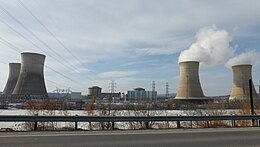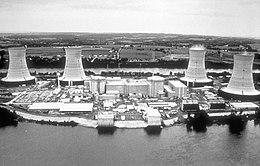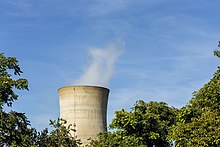
The Three Mile Island accident was a partial nuclear meltdown of the Unit 2 reactor (TMI-2) of the Three Mile Island Nuclear Generating Station on the Susquehanna River in Londonderry Township, near Harrisburg, Pennsylvania. The reactor accident began at 4:00 a.m. on March 28, 1979, and released radioactive gases and radioactive iodine into the environment. It is the worst accident in U.S. commercial nuclear power plant history. On the seven-point logarithmic International Nuclear Event Scale, the TMI-2 reactor accident is rated Level 5, an "Accident with Wider Consequences".

The Limerick Generating Station is a nuclear power plant in Pennsylvania located next to the Schuylkill River in Limerick Township, Montgomery County, northwest of Philadelphia. The facility has two General Electric boiling water reactor (BWR) units, cooled by natural draft cooling towers. According to its owner, Constellation Energy, the two units are capable of producing 2,317 megawatts of power, which combined would provide electricity to around 2 million households. Constellation owns and operates this facility following their separation from Exelon Corporation in 2022. With the exception of refueling outages, Limerick Generating Station continuously operates at 100% power. The plant is connected to the grid, and transmits power, via multiple 500kv transmission lines.

Oyster Creek Nuclear Power Station is an inactive single unit 636 MWe boiling water reactor power plant in the United States. The plant is located on an 800-acre (3.2 km2) site adjacent to Oyster Creek in the Forked River section of Lacey Township in Ocean County, New Jersey. At the time of its closure, the facility was owned by Exelon Corporation and, along with unit 1 at Nine Mile Point Nuclear Generating Station, was the oldest operating commercial nuclear power plant in the United States. The plant first started commercial operation on December 23, 1969, and is licensed to operate until April 9, 2029, but Oyster Creek was permanently shut down in September 2018. The plant got its cooling water from Barnegat Bay, a brackish estuary that empties into the Atlantic Ocean through the Barnegat Inlet.

Dresden Generating Station is the first privately financed nuclear power plant built in the United States. Dresden 1 was activated in 1960 and retired in 1978. Operating since 1970 are Dresden units 2 and 3, two General Electric BWR-3 boiling water reactors. Dresden Station is located on a 953-acre (386 ha) site in Grundy County, Illinois near the city of Morris. It is at the head of the Illinois River, where the Des Plaines River and Kankakee River meet. It is immediately northeast of the Morris Operation—the only de facto high-level radioactive waste storage site in the United States. It serves Chicago and the northern quarter of the state of Illinois, capable of producing 867 megawatts of electricity from each of its two reactors, enough to power over one million average American homes.

Braidwood Generating Station is located in Will County in northeastern Illinois, U.S. The nuclear power plant serves Chicago and northern Illinois with electricity. The plant was originally built by Commonwealth Edison company, and subsequently transferred to Com Ed's parent company, Exelon Corporation. Following Exelon's spin-off of their Generation company, the station was transferred to Constellation Energy.

The Byron Nuclear Generating Station is a nuclear power plant located in Ogle County, Illinois, 2 miles (3.2 km) east of the Rock River. The reactor buildings were constructed by Commonwealth Edison and house two Westinghouse Four-Loop pressurized water reactors, Unit 1 and Unit 2, which began operation in September 1985 and August 1987 respectively. The plant is owned and operated by Constellation Energy.

The Calvert Cliffs Nuclear Power Plant (CCNPP) is a nuclear power plant located on the western shore of the Chesapeake Bay near Lusby, Calvert County, Maryland, in the Mid-Atlantic United States. It is the only nuclear power plant in the state of Maryland.

The Robert Emmett Ginna Nuclear Power Plant, commonly known as Ginna, is a nuclear power plant located on the southern shore of Lake Ontario, in the town of Ontario, Wayne County, New York, United States, approximately 20 miles (32 km) east of Rochester, New York. It is a single unit Westinghouse 2-Loop pressurized water reactor, similar to those at Point Beach, Kewaunee, and Prairie Island. Having gone into commercial operation in 1970, Ginna became the second oldest nuclear power reactor, after Nine Mile unit 1, still in operation in the United States when the Oyster Creek power plant was permanently shut down on September 17, 2018.

The Peach Bottom Atomic Power Station is an American nuclear power plant that is located 50 miles (80 km) southeast of Harrisburg in Peach Bottom Township, York County, Pennsylvania. Situated close to the Susquehanna River, it is three miles north of the Maryland border.

The Sequoyah Nuclear Plant is a nuclear power plant located on 525 acres (212 ha) located 7 miles (11 km) east of Soddy-Daisy, Tennessee, and 20 miles (32 km) north of Chattanooga, abutting Chickamauga Lake on the Tennessee River. The facility is owned and operated by the Tennessee Valley Authority (TVA).

The Prairie Island Nuclear Generating Plant is an electricity-generating facility located in Red Wing, Minnesota, along the Mississippi River, and adjacent to the Prairie Island Indian Community reservation.

Nine Mile Point Nuclear Station is a nuclear power plant with two nuclear reactors located in the town of Scriba, approximately five miles northeast of Oswego, New York, on the shore of Lake Ontario. The 900-acre (360 ha) site is also occupied by the James A. FitzPatrick Nuclear Power Plant.
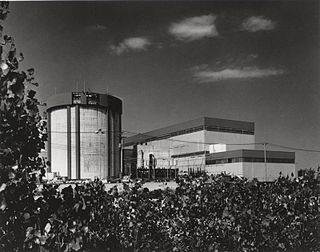
Zion Nuclear Power Station was the third dual-reactor nuclear power plant in the Commonwealth Edison (ComEd) network and served Chicago and the northern quarter of Illinois. The plant was built in 1973, and the first unit started producing power in December 1973. The second unit came online in September 1974. This power generating station is located on 257 acres (104 ha) of Lake Michigan shoreline, in the city of Zion, Lake County, Illinois. It is approximately 40 direct-line miles north of Chicago, Illinois and 42 miles (68 km) south of Milwaukee, Wisconsin.

The Clinton Power Station is a nuclear power plant located near Clinton, Illinois, USA. The power station began commercial operation on November 24, 1987 and has a nominal net electric output of 1062 MWe. Due to inflation and cost overruns, Clinton's final construction cost was $4.25 billion, nearly 1,000% over the original budget of $430 million and seven years behind schedule.

The Enrico Fermi Nuclear Generating Station is a nuclear power plant on the shore of Lake Erie near Monroe, in Frenchtown Charter Township, Michigan on approximately 1,000 acres (400 ha). All units of the plant are operated by the DTE Energy Electric Company and owned by parent company DTE Energy. It is approximately halfway between Detroit, Michigan, and Toledo, Ohio. It is also visible from parts of Amherstburg and Colchester, Ontario as well as on the shore of Lake Erie in Ottawa County, Ohio. Two units have been constructed on this site. The first unit's construction started on August 4, 1956 and reached initial criticality on August 23, 1963, and the second unit received its construction permit on September 26, 1972. It reached criticality on June 21, 1985 and was declared commercial on November 18, 1988. The plant is connected to two single-circuit 345 kV Transmission Lines and three 120 kV lines. They are operated and maintained by ITC Transmission.
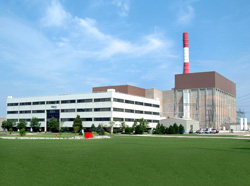
LaSalle County Nuclear Generating Station, located in Brookfield Township, LaSalle County, Illinois, near Marseilles, 11 miles (18 km) southeast of Ottawa, serves Chicago and Northern Illinois with electricity. The plant is owned and operated by Constellation Energy following separation from Exelon Corporation in 2022. Its Units 1 and 2 began commercial operation in October 1982, and October 1984, respectively.

Quad Cities Generating Station is a two-unit nuclear power plant located near Cordova, Illinois, United States, on the Mississippi River. The two General Electric boiling water reactors give the plant a total gross electric capacity of approximately 1,880 MW. It was named for the nearby cities of Moline, Illinois, Rock Island, Illinois, Davenport, Iowa, East Moline, Illinois, and Bettendorf, Iowa — known as the Quad Cities.

In the United States, nuclear power is provided by 94 commercial reactors with a net capacity of 97 gigawatts (GW), with 63 pressurized water reactors and 31 boiling water reactors. In 2019, they produced a total of 809.41 terawatt-hours of electricity, which accounted for 20% of the nation's total electric energy generation. In 2018, nuclear comprised nearly 50 percent of US emission-free energy generation.
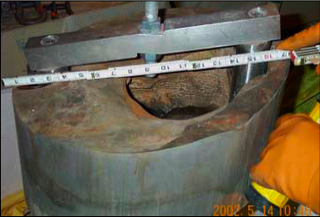
The United States Government Accountability Office reported more than 150 incidents from 2001 to 2006 of nuclear plants not performing within acceptable safety guidelines. According to a 2010 survey of energy accidents, there have been at least 56 accidents at nuclear reactors in the United States. The most serious of these was the Three Mile Island accident in 1979. Davis-Besse Nuclear Power Plant has been the source of two of the top five most dangerous nuclear incidents in the United States since 1979. Relatively few accidents have involved fatalities.

Nuclear power has been widely established in Pennsylvania since the 1950s and has grown to provide almost 25% of the energy produced in PA. This is achieved through the four active reactors currently operating. There are five inactive reactors in PA, including Three Mile Island, which had a partial meltdown and caused a reevaluation of nuclear reactor safety practices.




